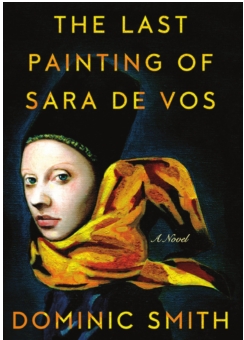"The Last Painting of Sara de Vos” by Dominic Smith is about a rare 17th-century painting that links three lives on three continents over three centuries. It’s a tangled mess, but hopefully held together, Smith said in a phone interview.
Smith said he is honored to be the guest speaker at Authors in April on April 29 at Margaritaville Casino at noon. The event benefits the Pioneer Heritage Center. Smith will talk about his new book and research surrounding art forgery. He said he looks for gaps in the history network for his books.
A local book club, Bibliofemmes, is reading the “The Last Painting.” There are 12 members, two since 1999. Rishea Richards picked the book because she likes to paint and read about art and the title appealed to her. She is looking forward to hearing Smith speak. The group will be painting on March 30 at Painting with a Twist and arriving early to discuss the book. Smith said it will be gratifying for them to grill him with specific questions. “I am optimistic about reading in America,” he said.
The fictional de Vos in 1631 becomes the first woman to be admitted as a master painter to the Guild of St. Luke. Though women do not paint landscapes (they are generally restricted to indoor subjects), a wintry outdoor scene haunts her. She cannot shake the image of a girl from a nearby village, standing alone beside a silver birch at dusk, staring out at a group of skaters on the frozen river below. Defying the expectations of her time, she paints it.
In New York City in 1957, the only known surviving work of de Vos, “At the Edge of a Wood,” hangs in the bedroom of an attorney, a descendant of the original owner. When a struggling art history grad student agrees to forge the painting for a dubious art dealer, she finds herself entangled with the owner.
Then as a celebrated art historian and curator, the former grad student is mounting an exhibition in 2000 in Sydney in her field of specialization: female painters of the Dutch Golden Age. When it becomes apparent that both the original “At the Edge of a Wood” and her forgery are en route to her museum, the life she has carefully constructed threatens to unravel.
Smith is a native Australian and has lived in Amsterdam. He writes in his garden studio in Austin. He has a B.A. in anthropology, having written his thesis on political graffiti in El Salvador.
Imagine the research, which took a full year. Smith used e-mails and watched videos, did field work and used personal experiences. He utilizes primary sources for historical periods and reads what is written during those times, “soaking in that world.”
It’s a backdrop to the writing itself, he said. Subject matter experts were willing to donate their time. Much of the information
he shares about fakes comes from forger Ken Pirenyi, who confessed in
his memoir “Caveat Emptor,” after being hounded for years by the FBI. He
and Smith corresponded via e-mail.
Smith physically walks around the spaces where his books are set. “I scout the novel for locations,” he said.
His
advice to aspiring writers is that you never really arrive. “I always
try to be better. It’s not a traditional career. You have to combine the
pragmatic with the aspirational.”
For
four years he made a livelihood in customer service while writing
fiction on weekends and in the evenings before taking a job in IT
management in Amsterdam and going to museums in his spare time, where he
came face to face with Dutch landscape paintings of the 17th century.
He
is in the early phase of his next project, set in the world of early
cinema. He said Fort Lee, N.J., was the first Hollywood. The book will
follow one film studio’s rise and demise of filmmaking.
Smith
serves on the faculty at the Warren Wilson MFA Program for Writers and
has taught at the University of Texas, Southern Methodist University and
Rice University.
– Mary Ann Van Osdell